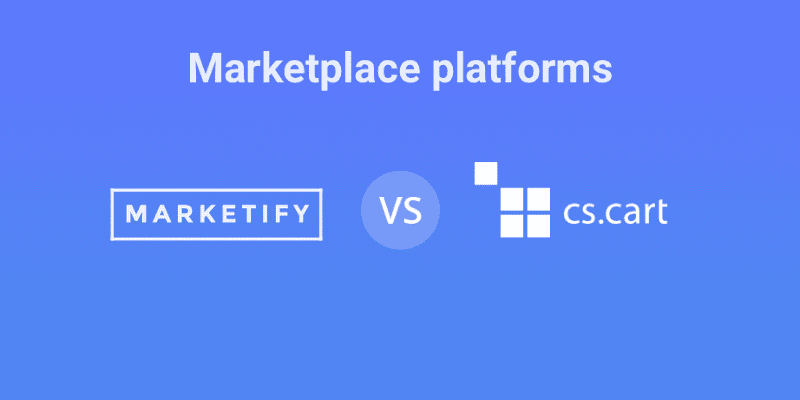WordPress + Marketify vs. CS-Cart Multi-Vendor marketplace system
Many people know about WordPress. It is a simple and popular platform with easy access to it. You can build a forum, blog, single-page site, or even a social network with it. However, you can also build an online store or even an online marketplace using your WordPress.
How convenient and strong it will be? How many necessary tools and features it will have?
Today we will find it out. In this article, I will compare an Astoundify Marketify plugin for WordPress with a professional platform for the online marketplace creation – CS-Cart Multi-Vendor. Jack of all trades or specialists? Who will perform better in the role of an Amazon-like site management system? Let’s find out!
Contents
- General information
- History and experience
- Success stories
- A marketplace management tools out-of-the-box
- Customizability
- Performance
- Go Mobile!
- SEO Tools
- Upgrade policies
- Tech support
- Community
- Partners
- Guides and tutorials
- Starting expenses
- Conclusion
You may also be interested:
Top multi vendor marketplace scripts
1. General information
Here we got two totally different products. On one side we have a CS-Cart
Multi-Vendor – professional eCommerce downloadable software.
On the other side – Astoundify Marketify – Digital Marketplace WordPress Theme.
So basically, it is not even a plug-in. Probably it will drastically affect its functionality and potency as an online marketplace solution, but we will not rush forward right now.
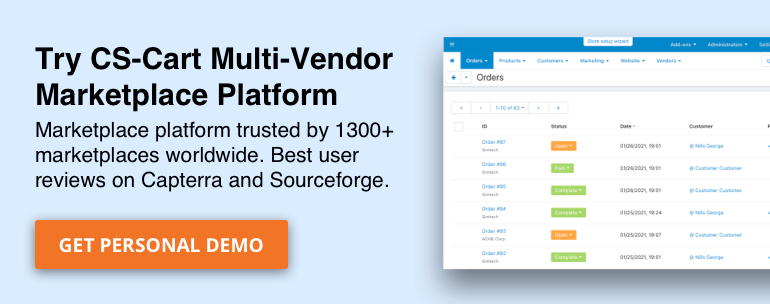
2. History and experience
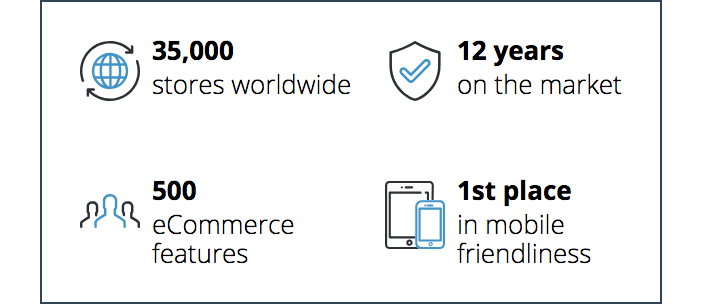
CS-Cart was founded in 2005. Our Multi-Vendor online marketplace solution went off in November 2010.
So it is running for 8 years already. On our site, you
can see that there are more than 35.000 online stores
and 1.300 online marketplaces built with CS-Cart
Multi-Vendor, so it makes this product the most popular
ecommerce solution for online malls in the world.
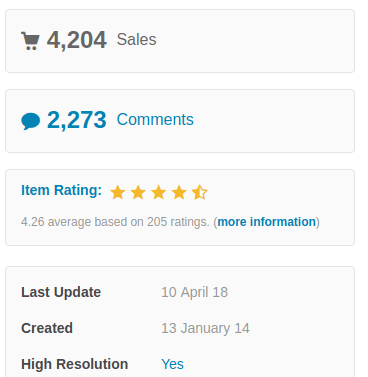
As you can see, Marketify was developed in 2014. Now it has more than 4,000 clients. Unfortunately, it is totally impossible to get any information on the successes of those projects.
3. Success stories
I always believe in the fact that successful online marketplace management software must have successful clients. Isn’t it? You find no comments in this section.
Below you can just find several projects built with Marketify and Multi-Vendor marketplace system and their popularity. Unfortunately, Marketify team did not provide me with any examples and just sent me to their site. There we can see three web stores of their clients:
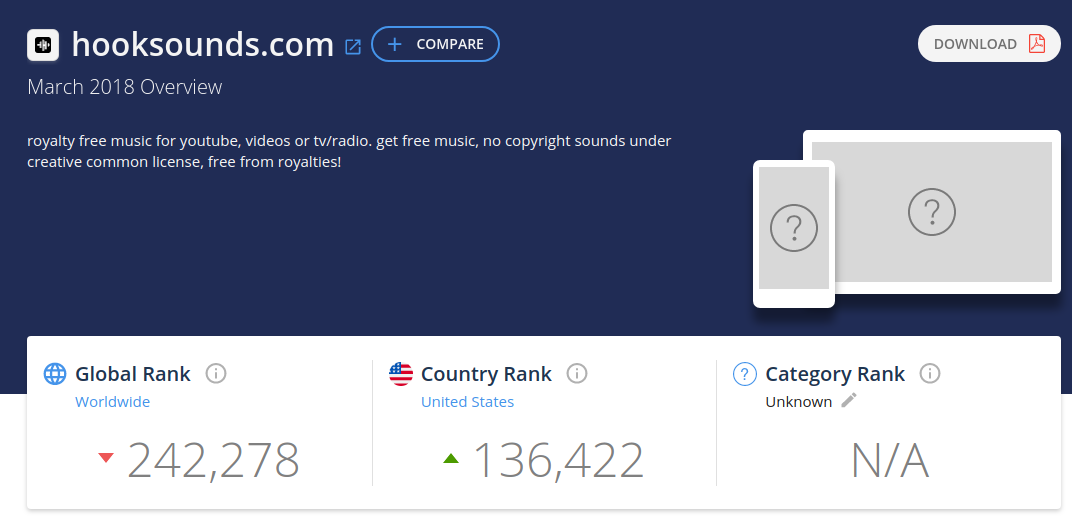
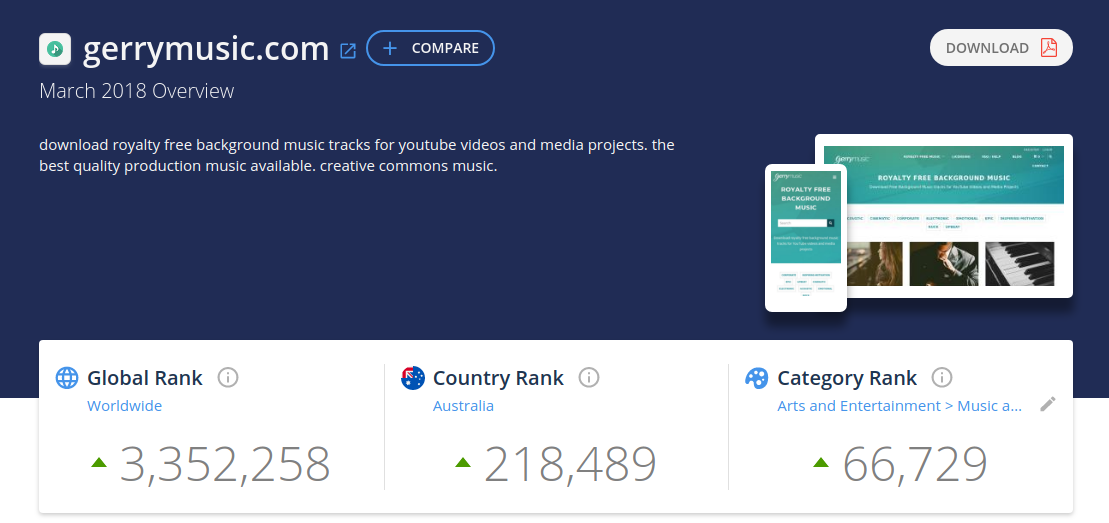
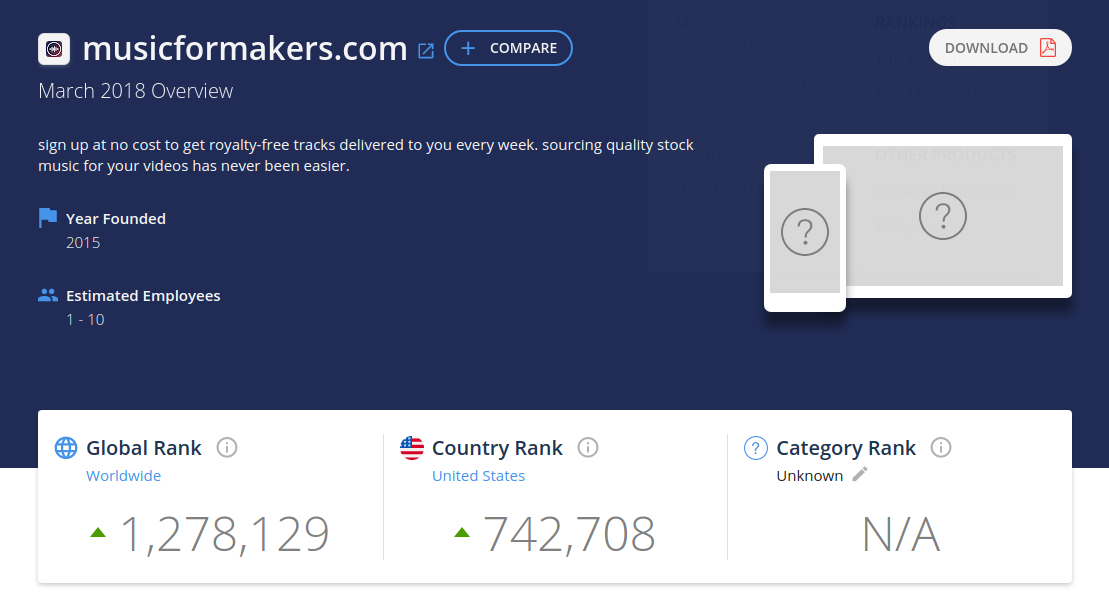
Pretty average statistics, as we can see. All these online stores have their customers.
However, none of them is multivendor. All three are a single-vendor store. So, unfortunately, we can not get any information on the success of Marketify virtual shopping malls.
And below you can find several CS-Cart Multi-Vendor examples:
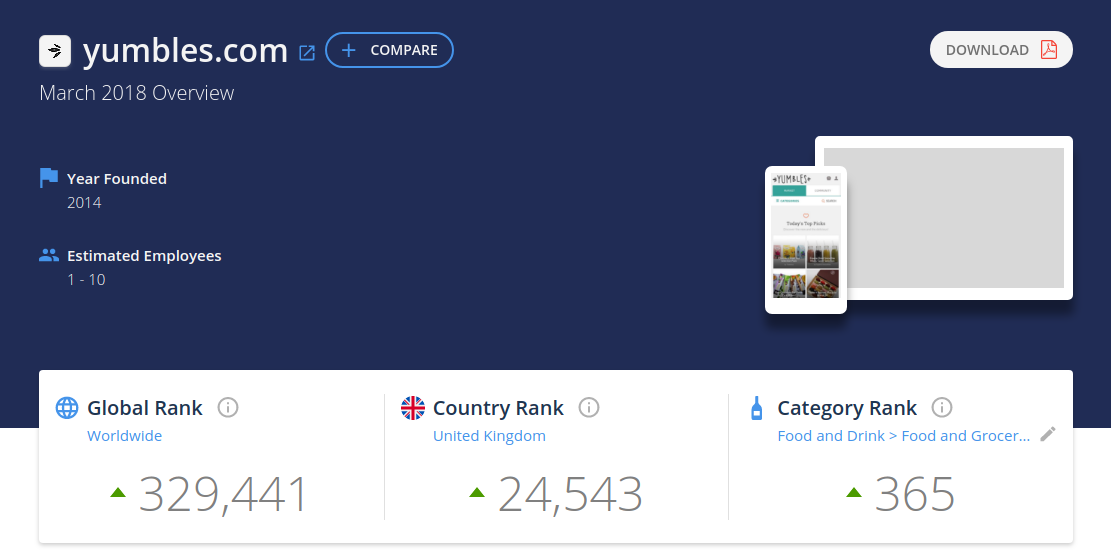
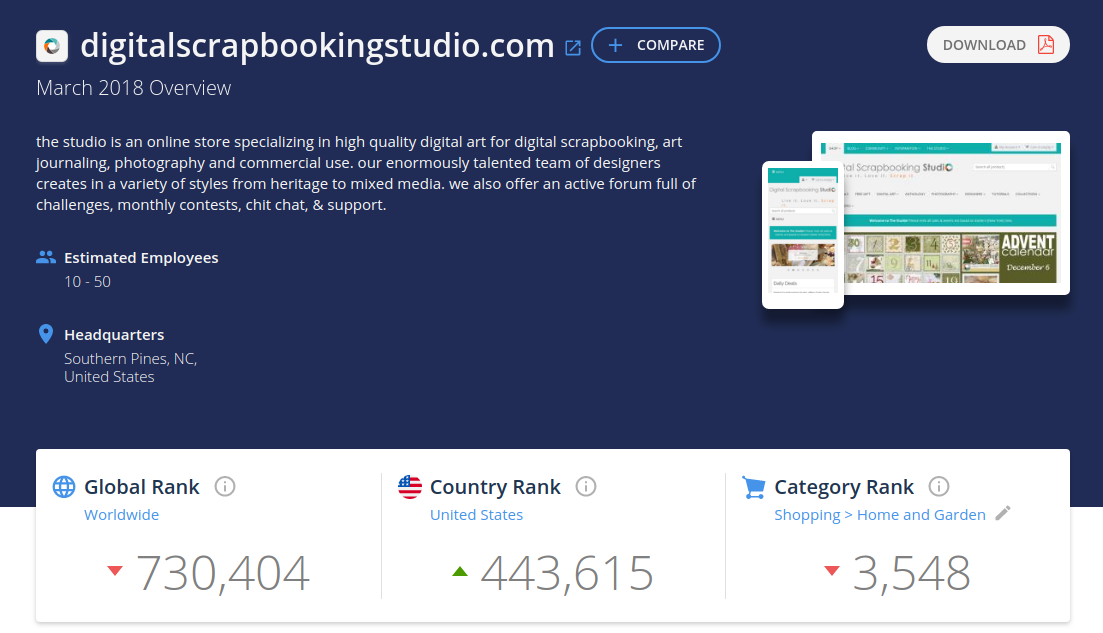
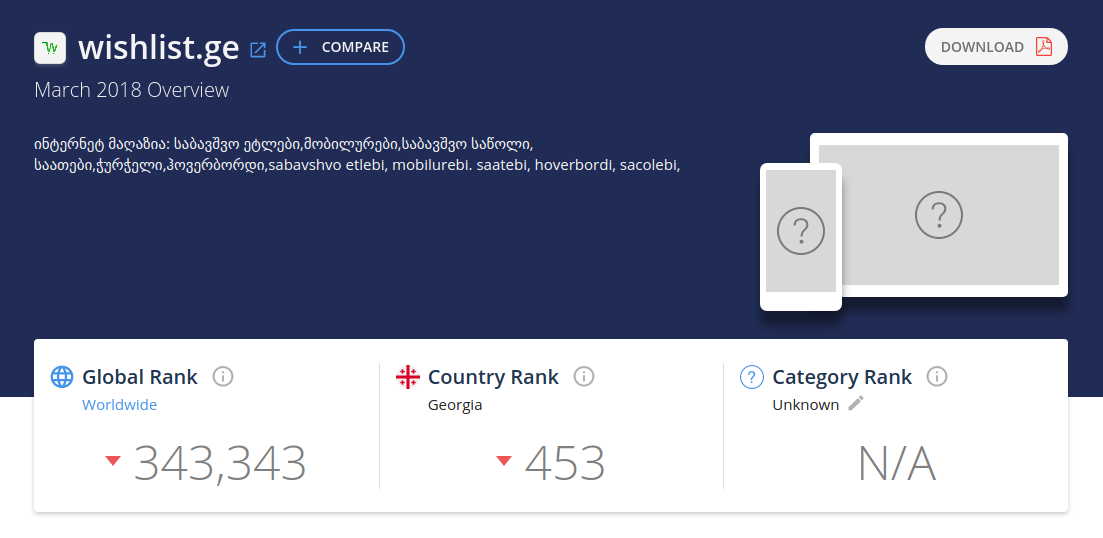
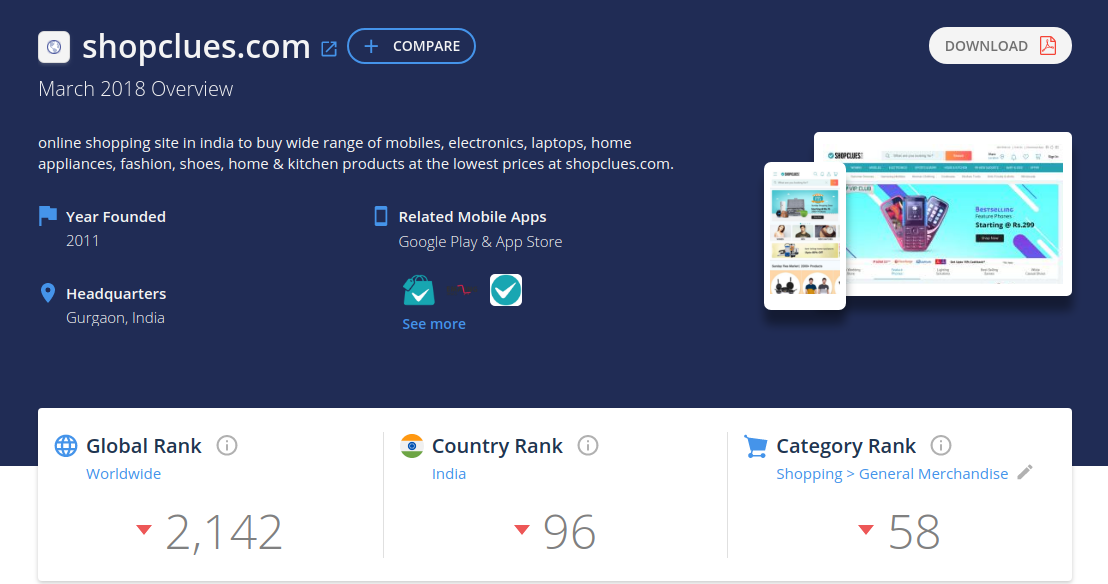
As you can see, Shopclues is very popular. It has more than 55.000.000 products and works great thanks to our Multi-Vendor eCommerce software. Also, we have a lot of other cases on our site, so feel free to familiarize yourself with them on this page.

4. Marketplace management tools out-of-the-box
The creation of your own marketplace is a big step in your business. It requires a lot of work, analytics, and planning. Also, it is great to know what are you paying for prior to purchase, isn’t it?
That is why there is one thing I find quite dishonest. Really frustrating to purchase a theme that highlights a ‘Feature’ only to find out the company requires an additional $199 to add that feature. So yes, Marketify will not allow you to build your own e shop mall. To make it work you need to buy Frontend submissions plugin for $199.
One really convenient thing your Marketify marketplace will get with Frontend Submissions – a complete drag-and-drop interface for building forms for vendor registration, product submission, and vendor account profiles, giving site administrators complete control over the form fields shown to online vendors. It’s really nice.
But this plugin does not allow your project to work as an online marketplace still. The thing is you can not get any profit from your vendors unless you… Guess what? Exactly! Unless you purchase some additional plugins. To have it working as a virtual shopping mall you need to get the Commissions plugin for $89 at least. No automated payouts though.
Do you want to have ANY marketing tools to actually SELL anything? Let me tell you about some of these plugins:
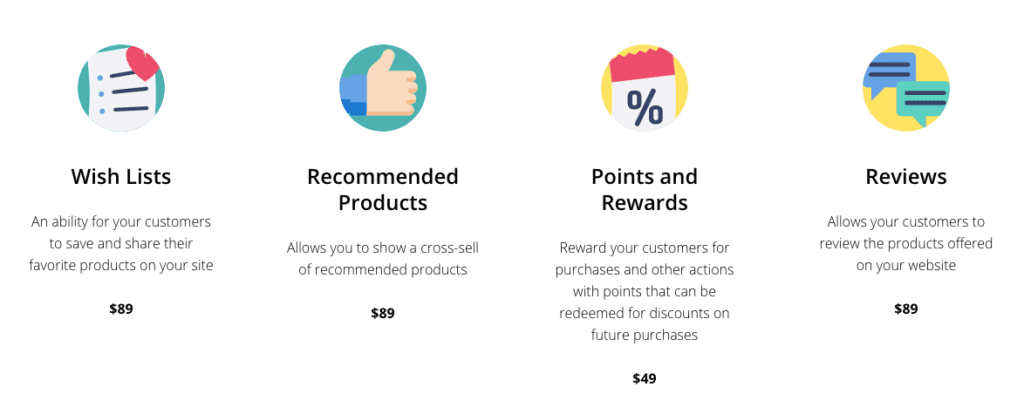
So it is $515 at a minimum to get an online multi-vendor marketplace with a very limited functionality with no automation at all. It is even unable to display a customer username when they are logged. This is not such a crucial feature, but it is very unpleasant to know that you have to get this plugin to make it work, so read more about it here.
Also, in Marketify there is no option for having both the Regular and Discount price available within the product. You can just have the Sale price displayed, you can also add variable pricing, but there is no way to show the full and discounted price. And in the Multi-Vendor eCommerce marketplace script you can easily do something like this:

So your customers can see the discounted products. You can even get all these products in the SALE category automatically. Do I need to tell you how it can raise your sales and profit as well?
So $515. That’s it? Not so much for an online marketplace solution. By the way, did I mention that all these payments are NOT one-time?

Yes, you get it right.ALLthese plugins are paid yearly. So you have to pay $199 for a marketplace ability, $89 for any necessary tool and $49 for extra usable but necessary features every year.
So, in general, it is like a cloud solution, but without maintenance, hosting service, support, and a little more expensive. Do you want more limitations? Let me tell you about the main one.
The Marketify theme has been specifically designed to be used to sell digital products. However, there are a few options to provide limited support for selling physical goods.
Since the theme relies on Easy Digital Downloads you can use certain extensions (such as Easy Digital Downloads Simple Shipping – $49 yearly) to add additional functionality to sell physical goods.
And here you will have a lot of limitations too. Please, take a look at the information below:
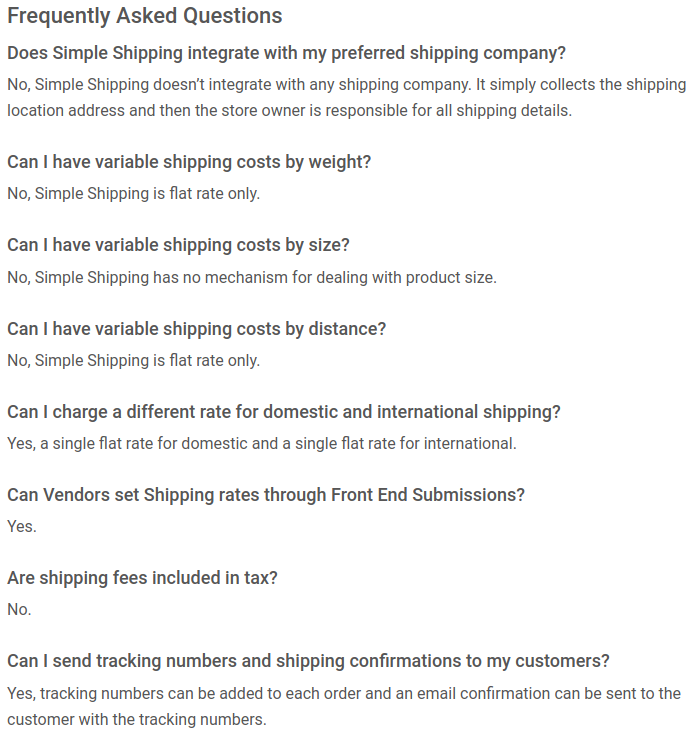
So basically this plugin will only add an “Input your address” form and 2 delivery costs for your customer. No automatization, automatic calculation of shipping rates depending on size, weight or distance. None of this is available.
To make it clear, your customers will pay the same amount for the delivery of a single DVD to a neighboring country and for the delivery of a man-tall refrigerator to the other end of the world. Not very convenient, is it?
Please note, according to the Marketify documentation the focus of Astoundify Support Services is to help get the theme set up like their demo. Therefore, they do not provide any support in helping get the theme set up to sell physical products. They are partnered with and highly recommend WP Curve, Envato Studio, or Codeable if you need help setting up Marketify to be used to sell physical products.
One more necessary tool for an e-shop mall – is an Import/Export tool. This will allow you and your vendors to upload multiple goods at once. And this feature is crucial to the success of such a project. Below you can find a reply from Marketify about such a tool:
Marketify is just a theme powered by Easy Digital Downloads. The Theme itself does not have actual importer Tools.
But you can import to EDD through the WordPress settings or using WP All Import. Just keep in mind Marketify is meant to be a Digital Product Marketplace.
On another hand, we have a CS-Cart Multi-Vendor with all these (and around 450 more) tools included out-of-the-box for the one-time payment. It costs $1450. Once. For a lifetime license.

You can find a short chart with a comparison of marketplace features, included in the CS-Cart Multi-Vendor marketplace system and Marketify out-of-the-box below.
| Features | Multi-Vendor | WordPress + Marketify |
| Multi-Vendor specific features | ||
| Vendor plans | ✅ | ⛔️ |
| Manual vendor approval | ✅ | ✅ |
| Unlimited vendors and products | ✅ | ✅ |
| Manual product approval | ✅ | ✅ |
| Automatic product approval | ✅ | ⛔️ |
| Order email notifications | ✅ | ✅ |
| Advanced search by vendors, products, orders, users | ✅ | ⛔️ |
| PayPal Adaptive | ✅ | Yes only if you have a profile already |
| Refunds | ✅ | ⛔️ |
| Vendor rating | ✅ | ⛔️ |
| General | ||
| API access | ✅ | ⛔️ |
| Ebay integration | ✅ | ⛔️ |
| Facebook Store | ✅ | ⛔️ |
| Mobile app | ✅ | ⛔️ |
| Store geo location | ✅ | ⛔️ |
| Multiple currencies, taxes | ✅ | ⛔️ |
| Full access to the source code | ✅ | ⛔️ |
| Multiple languages | ✅ | ✅ |
| Design | ||
| Block manager (Layout editor) | ✅ | ✅ |
| Built-in template editor | ✅ | ✅ |
| Responsive themes | ✅ | ✅ |
| On-site editing | ✅ | ✅ |
| Drag-n-Drop Form editor | ⛔️ | ✅ |
| Product Catalog | ||
| Built-in Import/Export tool | ✅ | ⛔️ |
| Bulk product editing | ✅ | ⛔️ |
| Google export | ✅ | ⛔️ |
| Search | ✅ | ⛔️ |
| Marketing & Promotional Tools | ||
| Abandoned carts | ✅ | ⛔️ |
| Comments and reviews | ✅ | ⛔️ |
| Customer testimonials | ✅ | ⛔️ |
| Discount coupons | ✅ | ⛔️ |
| Gift certificates | ✅ | ⛔️ |
| Gift registry | ⛔️ | ⛔️ |
| Membership discounts | ✅ | ⛔️ |
| Membership only products/categories | ✅ | ⛔️ |
| Newsletters | ✅ | ⛔️ |
| Reward points | ✅ | ⛔️ |
| Special offers | ✅ | ⛔️ |
| Subscriptions | ✅ | ⛔️ |
| Customer features | ||
| Call requests | ✅ | ⛔️ |
| Feature comparison | ✅ | ⛔️ |
| One-page checkout | ✅ | ✅ |
| Product filters | ✅ | ⛔️ |
| Social login | ✅ | ⛔️ |
| E-mail notifications | ✅ | ⛔️ |
| Admin area features | ||
| Built-in database backup/restore tool | ✅ | ⛔️ |
| Drop shipping | ✅ | ⛔️ |
| Multiple levels of administrative access | ✅ | ⛔️ |
| Sales reports | ✅ | ✅ |
| Admin SMS notifications | ✅ | ⛔️ |
| Vendor micro-stores | ✅ | ⛔️ |
| Search Engine Optimization | ||
| Breadcrumbs | ✅ | ⛔️ |
| Meta tagging | ✅ | ⛔️ |
| Search Engine Friendly URLs | ✅ | ⛔️ |
| Sitemap | ✅ | ⛔️ |
| Google rich snippets | ✅ | ⛔️ |
| Canonical URL and 301 redirects | ✅ | ⛔️ |
| Shipping methods | ||
| Australia Post | ✅ | ⛔️ |
| Canada Post | ✅ | ⛔️ |
| DHL | ✅ | ⛔️ |
| FedEx | ✅ | ⛔️ |
| Intershipper | ✅ | ⛔️ |
| UPS | ✅ | ⛔️ |
| USPS | ✅ | ⛔️ |
| Manual shipping methods | ✅ | ⛔️ |
| Support & Community | ||
| Professional technical support | ✅ | ✅ |
| Community forums | ✅ | ⛔️ |
| Documentation | ✅ | ✅ |
| Official video instructions | ✅ | ⛔️ |
| Marketplace with themes and add-ons | ✅ | ✅ |

5. Customizability
The set of eCommerce tools and possibilities of both multi-vendor marketplace platforms can be expanded by a number of ready-to-use add-ons.
Astoundify has several plugins compatible with their Marketify theme. So you can extend its functionality to some degree, but it can not be as powerful as regular eCommerce software.
In case, of Multi-Vendor, we have our own Marketplace. We have almost 400 partners, and many of them creating new add-ons for our Multi-Vendor marketplace management software. There you can find a lot of solutions – from delivery methods to design themes.
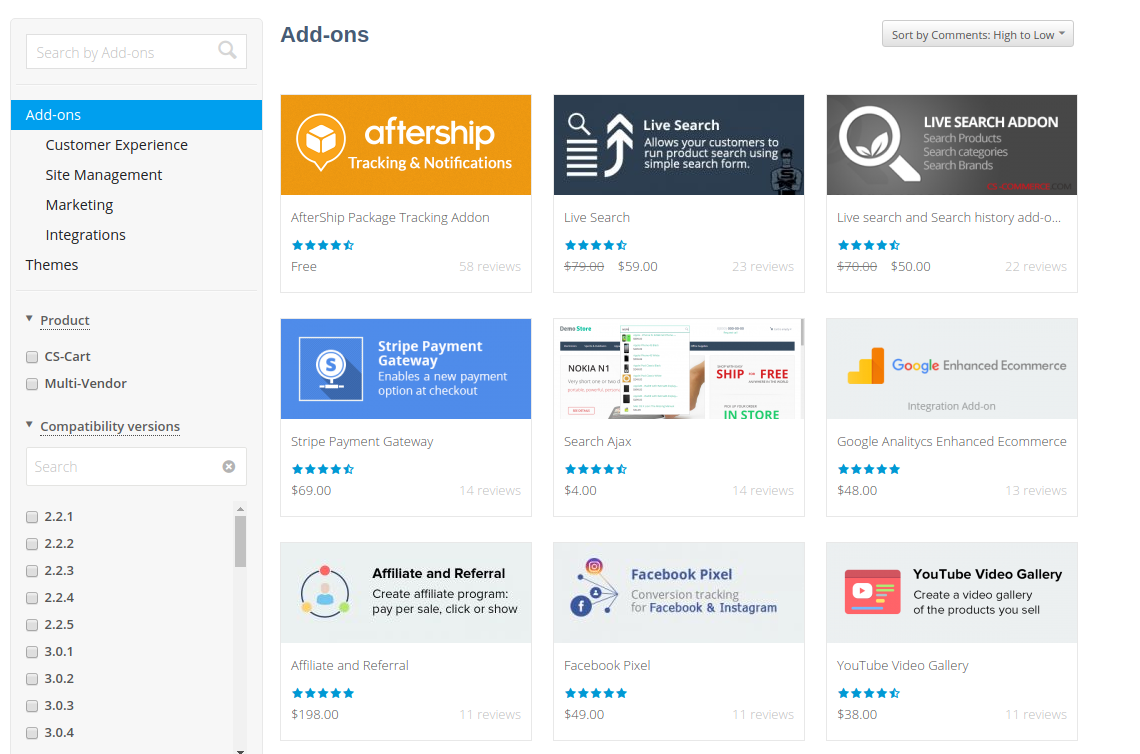
Also, Multi-Vendor will allow you to modify the source code. So you can ask our partners or some third-party developers to customize a ecommerce marketplace platform for your needs if you need to.
6. Performance
One important thing for your virtual shopping mall – is a performance. Your customers want to browse your goods fast and smoothly. You and your vendors want to upload and edit their products with no freezes.
At last, search engines will set your site closer to the top
of the list in case you have higher performance than your competitors.
This aspect is not the thing you have to worry about constantly, but you need to know for sure that your online marketplace software make its best to help you to get your profit.
That is why I have asked a Marketify team to share their performance data with me. You can find their answer below:
Marketify is coded to meet WordPress Standards. It will perform as best as possible, but you can further optimize it using plugins and tools available for WordPress.
Of course, I wish for a more detailed answer. However, that is all they can provide me with. Let’s compare it to our team reply:
Multi-Vendor works perfectly well with up to 1,000,000 products. If you plan to have more than 1,000,000 items, it may require some extra optimization. In this case, you would surely need to rent a high-productive dedicated server.
Our platform uses a lot of tools to optimize page speed. In particular:
1) Gzip for HTML, CSS, JS
When a customer opens the web page, the server starts sending web page files (HTML, CSS, JavaScript) to the customer’s browser.
Gzip reduces the size of these files. The smaller the page files, the faster they are delivered to a customer’s browser.
2) Lazy Image Loading
With lazy image loading the images on your storefront are loaded only when a customer scrolls to them.
Lazy image loading reduces server load and makes a web page load faster.
3) Deferred Script Loading
Customers cannot see the scripts because the scripts are a part of an HTML page and stand for animations and interactive content. It’s important to show what a customer can actually see on the web page first.
Scripts are loaded last and don’t block loading of the images and other visual content.
4) Built-In Cache
The built-in caching engine caches template data and MySQL data into the memory. When Multi-Vendor needs that data again, the cached template data and MySQL query results are quickly retrieved from the memory.
5) xCache, Redis, APCu
Multi-Vendor supports xCache, Redis, and APCu caching technologies. These accelerators cache Multi-Vendor data into the memory. Getting the data from the memory is always faster than generating it from scratch.
6) OpCache
OpCache accelerates PHP scripts by saving byte codes into the memory. When Multi-Vendor calls the same PHP script, the pre-cooked byte code is retrieved from the memory. Retrieving the byte code from the memory is faster than compiling the PHP script again.
In case you need to optimize your site in the nearest future, you can use our documentation on “How To: Increase the Performance of Your Store“.
I would also like to mention that we released a new version notable for its operation speed. For more information about speed optimization, please refer to the following page.
Kindly be advised, that there has been made a performance testing recently. It showed that our software can handle 980 transactions per second for a store with 200,000 products.
It means about 8,800,000 transactions, not from the cache plus 75,800,000 transactions from the cache per 24 hours!
Regarding speed performance, please refer to this page for more detailed information.
To demonstrate the stamina of a properly configured CS-Cart store with full-page caching, we’re presenting a special high load demo and its test results.
You can check it by yourself:
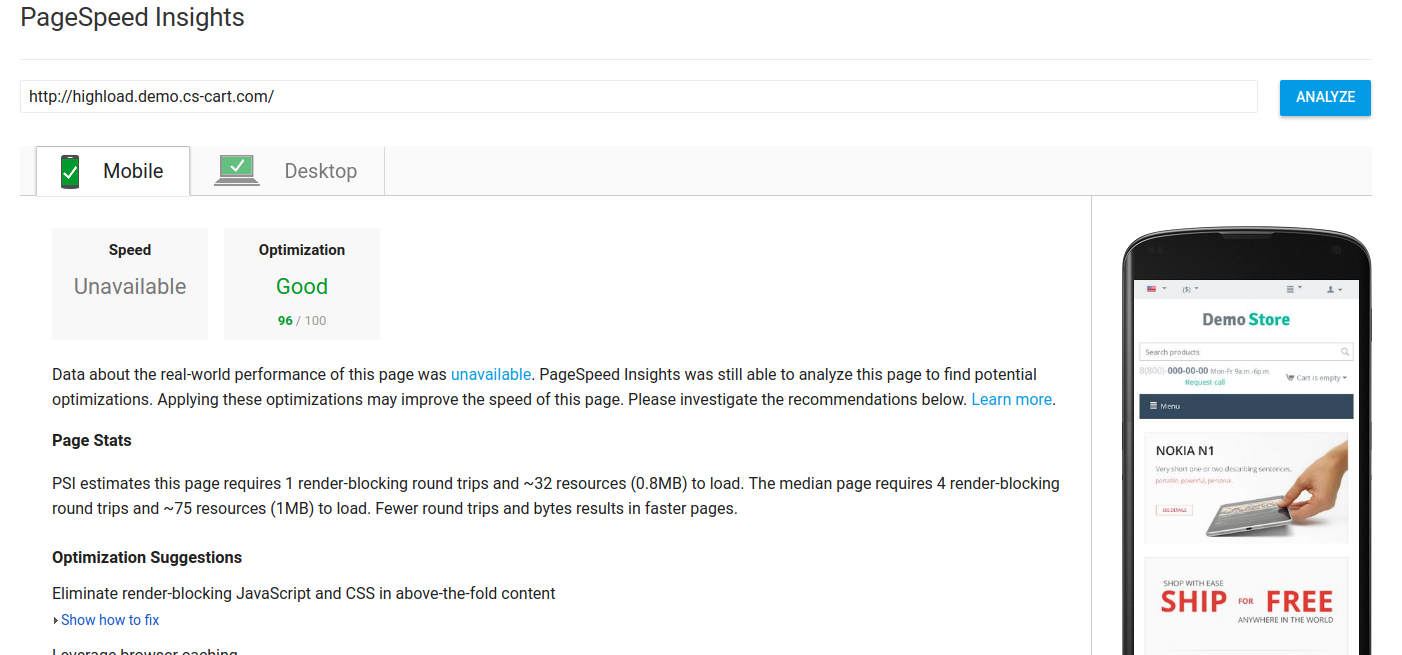
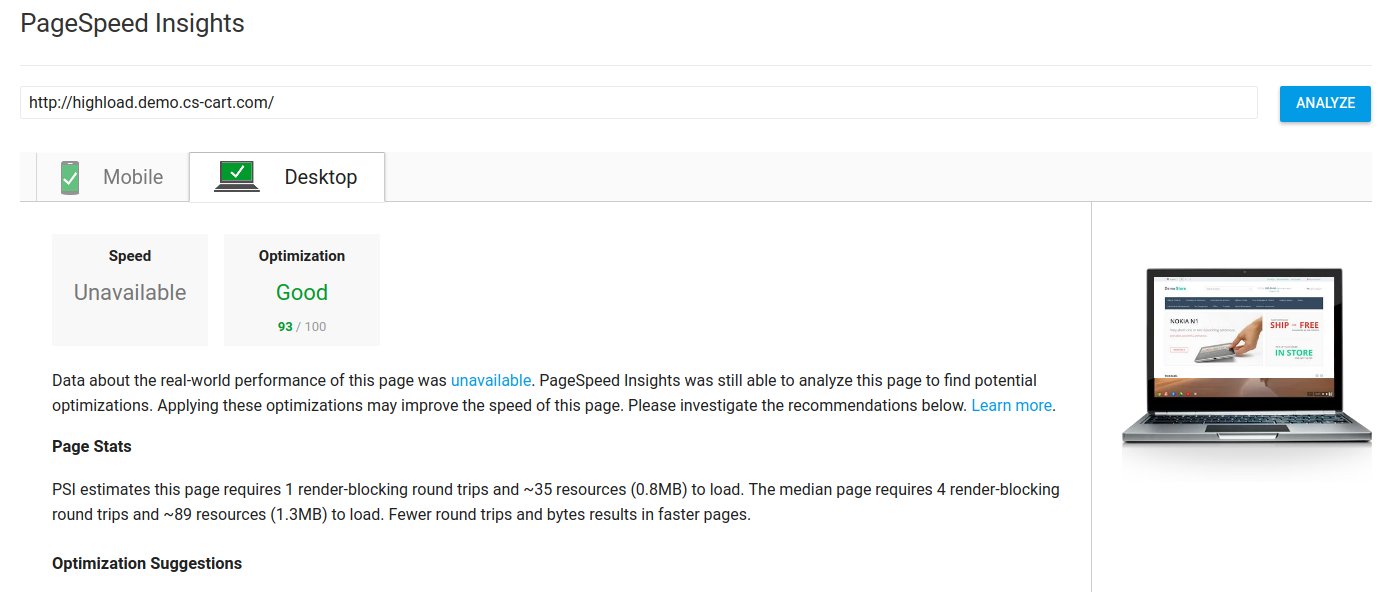
I am not a developer and not a technical person at all. Yes, all this information is unnecessary to me. But it will be very helpful for my administrator or developer if I desire to launch my own online marketplace.

7. Go Mobile!
Marketify has no way to add a mobile app to your project. As Astoundify representative stated: “We only develop WordPress themes for sale on here.
And we have a mobile App for Multi-Vendor. You can check it on Google Play and AppStore. The app is brought to you by the same people who develop the Multi-Vendor online marketplace solution. They know the ins and outs of the software and develop the app alongside it.
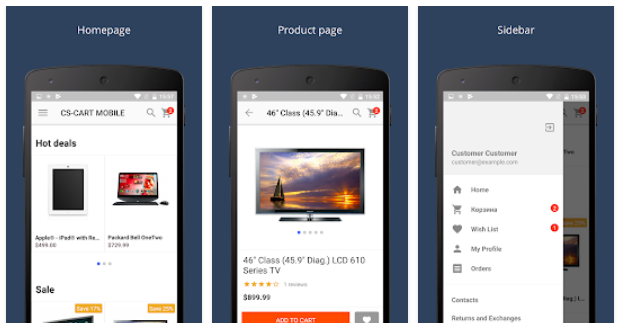
You pay once for the mobile app ($495), and then $90 per month for maintaining your mobile application by our developers.
We’ll publish the app on Google Play and Apple App Store for you. You won’t be left behind when a new version of the Multi-Vendor marketplace system version releases and the app has to be updated.
8. SEO Tools
Looking for more information on Marketify, I have found one interesting resource.
There you can find a short description and a couple of tests for WordPress plugins. Let’s take a look at the Marketify plugin for an online marketplace:
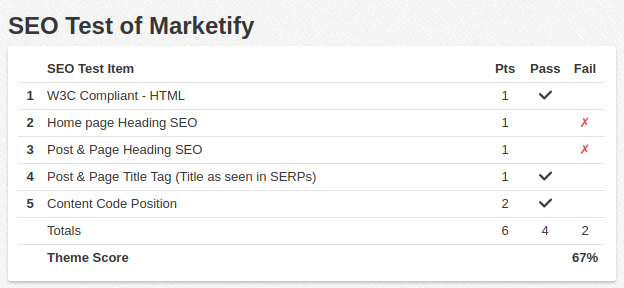
The details of each of the tested criteria above are given here.
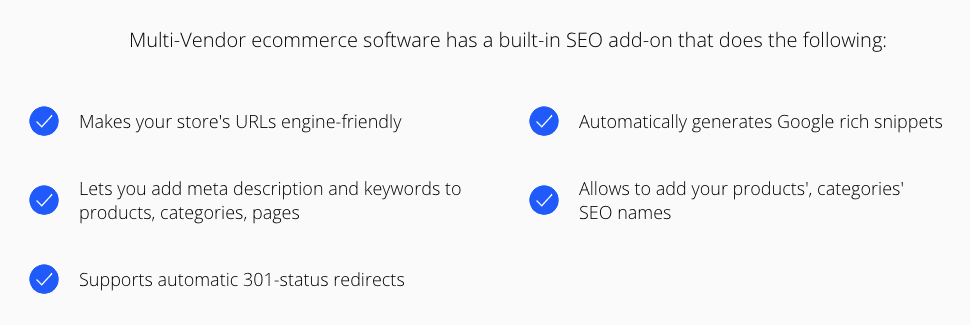
Search engine-friendly SEO is very important for your business. It allows you to get more visitors and as a result, more customers. So powerful SEO tools will come in handy very soon.
9. Upgrade policies
On purchasing a Multi-Vendor license, you get free access to new versions and upgrades for 1 year. After that, if you want to upgrade your web store, the upgrade subscription should be prolonged. However, you can continue using one of the versions without paying for the upgrade subscription.
More detailed information on our upgrade policy is here.
Marketify will be upgraded automatically until you pay for it.
10. Tech support
One of the main services – tech support. This is the thing that will help your virtual shopping mall to work properly and, as a result, earn you money.
A Marketify purchase includes support for 6 months from the purchase date. During those 6 months, the author is expected to be available to provide the item support services. Response time can vary depending on the volume of inquiries, the nature of the request, and whether questions have already been answered or support has already been provided (see “fair-use” later on).
If you’re about to purchase the item, you’ll have the option to purchase extended item support, increasing the item support period up to a maximum of 12 months from the date of purchase.
themeforest.net/page/item_support_policy
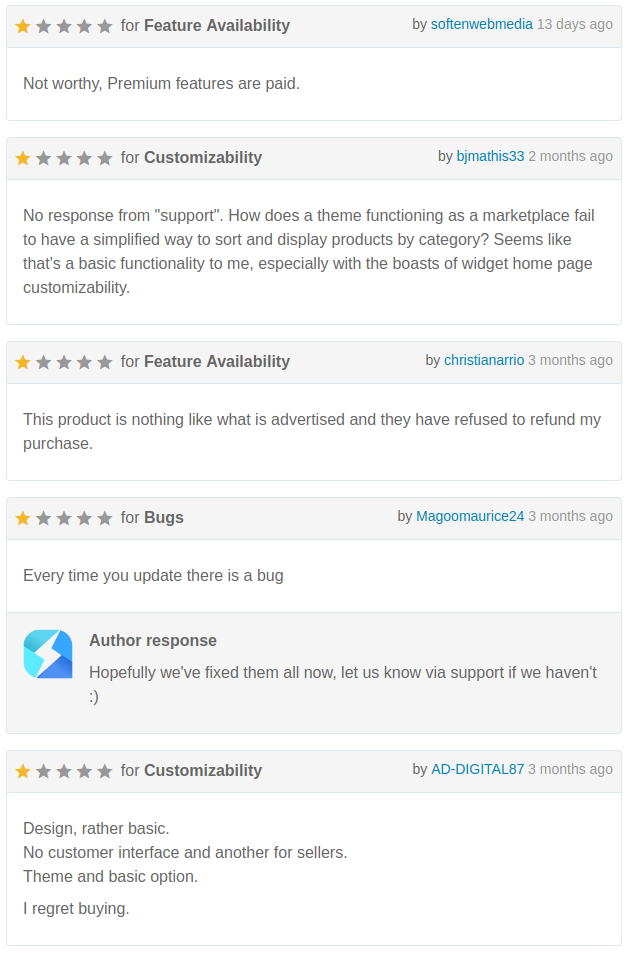
Looks like there are a lot of bugs, low customizability and total lack of true marketplace tools. However, not everything is so bad. For example, Marketify has a great customer support:
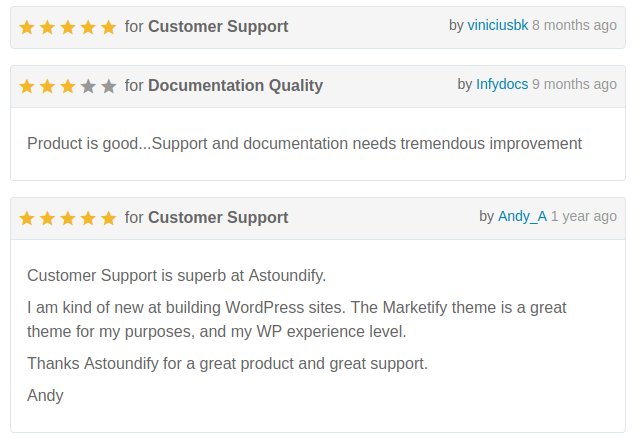
Unfortunately, I have to wait 4 days to get a response to my first question. However, all consecutive questions were replied to within 2 days.
And let’s compare it to the Multi-Vendor tech support. Each Multi-Vendor license is bundled with 90 days of free technical support. Our technical support specialists will be glad to help you if you have any questions.
We provide Issue-based support – when consultations of our technical support specialists are assessed in credits that are deducted from your credit account.
Credits are used up depending on the work required to answer your question, resolve the issue and have no time limit.
For more information please check the following page.

11. Community
As you probably see above, all the Marketify community can be found in a single Comments section on the Marketify selling page. It has around 2.200 posts right now. However, it is more like “I have an issue” – “Please, leave a ticket to our tech support” conversations, and not an actual community.
On the other hand, we have a CS-Cart community with its live forum. Moreover, there are more than 500 different users who visit a forum per hour usually! There you can fix some minor issues, talk to Multi-Vendor developers to know their plans for the nearest future, find a hosting, get a localization, advice, tips, free add-ons, and much more.
And this is not an advertisement, you can actually take a look at our forums here.
12. Partners
Let’s take a look at the partners and developers available for each of these online marketplace software.
Astoundify Marketify by itself does not have any authorized partners. They develop some plugins by themselves, that’s all. They do not provide customization services, but you are free to customize the theme any way you wish.
Of course, there are a ton of WordPress developers worldwide, however, very few of them can customize a third-party plugin like Marketify. Even those who do it will take no responsibility for it to work correctly after a couple of updates.
Finding a developer at an affordable price is much easier when there are a ton of such developers. However, get a qualitative service is another challenge. Almost none of the thousands of WordPress developers worked with Marketify.
So it will be really hard to find someone to add some functionality. Looks like Marketify users will have to go with a default configuration plus Astoundify plugins.
CS-Cart has 365 authorized partners and 248 of them are developers. Moreover, more than 120 companies can provide you with a turnkey website.
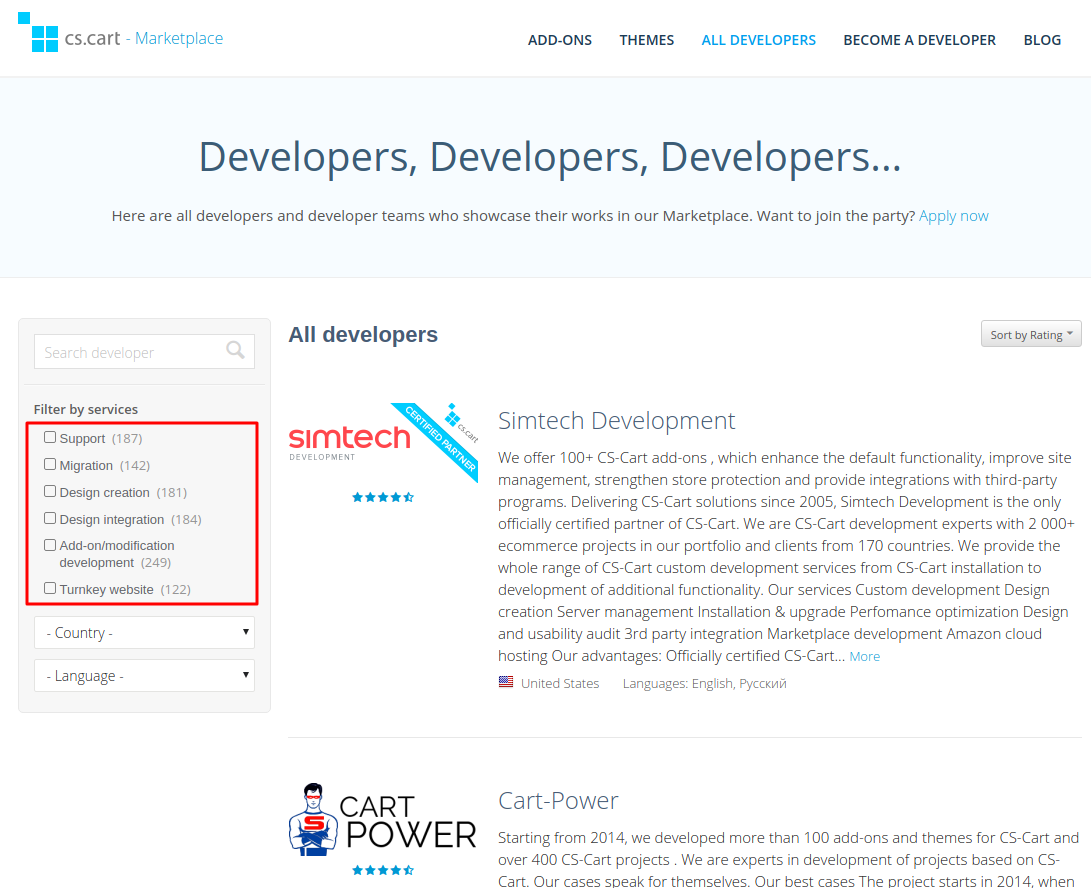
Also, there are 106 resellers worldwide. Many of them offering a country-based repacks with additional built-in tools for that region or country.
So, no competition here. Just raw facts for you to take a closer look.

13. Guides and tutorials
As you probably know, any CMS is a pretty complex system. So it can take a while for you and your online vendors to get familiar with it and start working efficiently. And there is only one tool which will be available to you for 24 hours 7 days a week – guides.
Let’s find out how simple it would be to get familiar with both ecommerce marketplace platforms.
Marketify has very humble documentation.
It is not very complex but it is so due to the lack of functionality. And even the existing tools are described very briefly. For example, there you can not even find a word about ways your customers can pay for the goods they purchase. Looks like it is up to you to figure out how to get profit from your e-shop mall.
So, would it be hard to get familiar with Marketify documentation? No. And would it be enough to run and manage your own marketplace? And to teach your vendors to work with it? No.
And now let me compare it with the CS-Cart Multi-Vendor guides. On our site, you can find documentation and – very convenient – video tutorials.
| ✅ docs.cs-cart.com | ✅ cs-cart.com/cs-cart-video-tutorials |
| ✅ cs-cart.com/multi-vendor-video-tutorials | ✅ https://www.youtube.com/watch?v=UuNs… |

Videos will allow you to get a general information on how to work with Multi-Vendor ecommerce marketplace software. Also, they can become a very good assistant for your vendors. But the documentation is great! Just take a look by yourself. There you can find an answer to literally any question about Multi-Vendor default functionality.
How to add products and categories, how to set design, to register and approve vendors, to set promotions, to manage your customers, to use manual and automated payouts and much much more. You do not have to read all articles at once, but many of them will become very helpful to you sooner or later.
With our guides and tutorials, you will always feel confident about your marketplace project development.
14. Starting expenses
Let’s make some calculations. To set up a Marketify theme, you need to have a WordPress site first. The cheapest WordPress plan, which allows you to have your own domain costs $250 monthly. You can use a free one, but in this case, you cannot have your own domain. And this is not the way to set your virtual shopping mall.
So, $250 monthly at first. Marketify itself costs $69 only. Another $49.88 for support every 6 months. Not so much, isn’t it? However, let me notice, that using Marketify out-of-the-box, you will get almost no tools to actually sell something. For example, you can find the following article in the FAQ:
marketify.astoundify.com/article/1024-what-paid-plugins-are-used-on-the-marketify-…
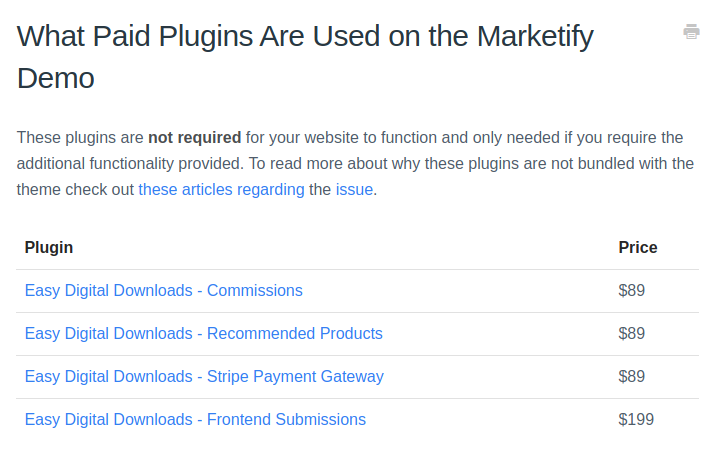
As you can see, the ability to take commissions (the main source of your income in your virtual marketplace) isn’t included. It costs an additional $89. Frontend submissions – another $199. And these are only two must-have add-ons you have in the demo (do you remember it has no functionality at all?). And all of these – are yearly payments, not one-time.
So as I mentioned above, it is $515 yearly to just make it work somehow. And this is for downloadable goods only. If you want to actually sell something, you definitely need marketing tools, a shipping plugin, and much much more. I have tried to compose something close to the Multi-Vendor functionality, but I can not. It will cost me more than $2800 yearly plus $3000 yearly for WordPress and I and my vendors will still be very limited in our possibilities.
Let’s take a look at our online marketplace software. To launch your own shopping mall built with a CS-Cart Multi-Vendor, you need to find a suitable hosting ($3 – $450 monthly, but usually $6 or $10 per month), SSL certificate for it ($70 yearly on average) get a license ($1450 once), probably get some custom design theme from Marketplace ($50 – $200), another $599 for the mobile app. That is all. You can invest the rest of your budget into advertising, for example.
So the total will be around $1600 plus a hosting with SSL – another $15 every month. This the way you will get three months of tech support and a year of free upgrades for your project.

15. Conclusion
Unfortunately, I have to state here, that with Marketify you just can not start your own online marketplace. Yes, you can create a simple single-vendor online store to sell audio files, but that is all. No way to create something similar to Amazon or any other online marketplace.
Probably, even open-source free software will be better here. However, Marketify uses WordPress as a basis, it is pretty simple to install and manage. But trying to create an e-shop mall with it will be a huge mistake.
Long story short, just take a glance look at the Features chart above. I am sure you will catch all the difference. If you find any mistakes or inaccuracies here, please, contact me.
Thank you for your time! Have a nice day and good luck with your project!
Yan Anderson is the Head of Content Marketing at CS-Cart with over 10 years of experience in the eCommerce industry. He's passionate about explaining complicated things in simple terms. Yan has expertise in building, running and growing eCommerce marketplaces. He loves to educate people about best practices, new technologies, and trends in the global eCommerce industry.
